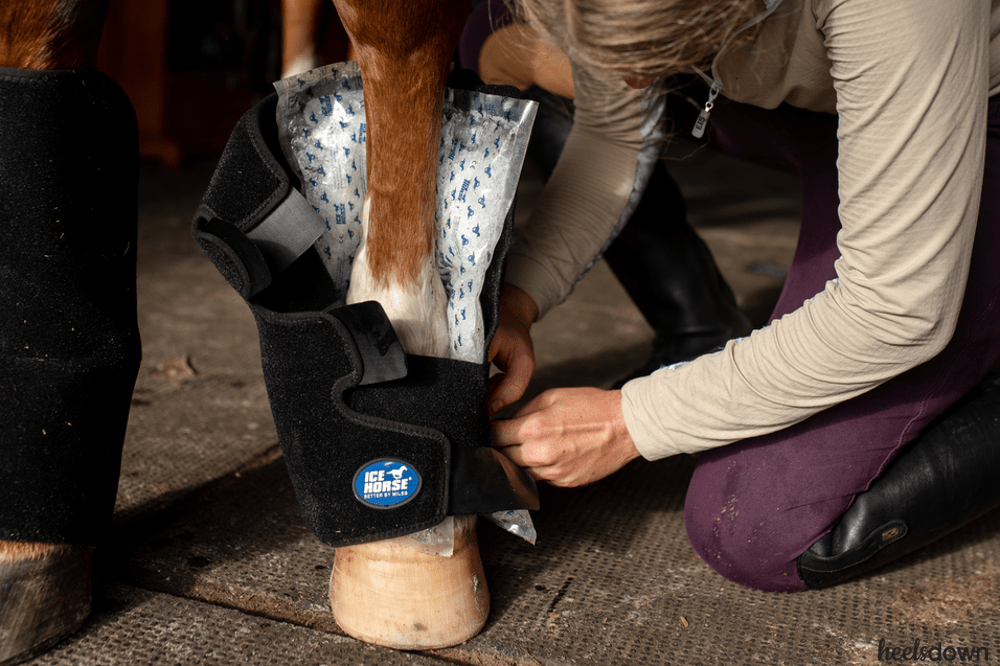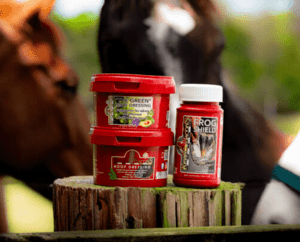Treating The Suspensory Injury: What You Need To Know

A suspensory injury. It’s three simple words when strewn together by a veterinarian can feel like a death sentence to any competitive rider.
For 23-year-old Katherine Lambert, she could tell her off-track Thoroughbred, McFly, was a “little off” one day while riding on the flat back in 2014. At the time, the pair were competing at the Preliminary level in eventing.
“He had some positive flexion in his right hind, and the vet came the next day to ultrasound his fetlock,” said Katherine, who now is now attending dental school in Portland, Maine. “It was then that he saw a ‘disruption’ of the medial suspensory branch. The sesamoid bone was also disrupted, where the suspensory branch connected.”
While an injured suspensory ligament is rarely a fatal injury, it often comes with a lengthy recovery period of stall rest and limited under saddle work.
There are a variety of ways to treat a suspensory injury. But it’s important to understand the ligament and how to works to truly comprehend how to treat and prevent damage to it.
So what is it?
The suspensory ligament, which attaches at the back and the upper cannon bone in both the fore front and hind limbs, supports and protects the fetlock from hyper-extension. It’s a long ligament, which runs close to the back of the cannon bone before splitting in two, where it connects to one of the sesamoid bones at the back of the fetlock.
While the suspensory ligament is strong, it’s not overly elastic. Too much stress can cause it to over-stretch, and ultimately damage it. Horses generally injure the suspensory ligament when landing after a jump or while traveling at high speeds. Usually injury occurs over a period of time and strain, and is not necessarily limited to one incident.
Damage can range from slight tears in the fibers of the ligament to an actual hole in it, which can be diagnosed via ultrasound. In extreme cases, horses can rupture the ligament.
Diagnosis can be tricky
Because there isn’t necessarily “heat” in the leg at the source of a tear or strain in soft tissue, diagnosing a suspensory injury can be difficult. Lameness in the affected limb can be subtle, but will get worse over time if not treated. Generally, the horse will become weaker, especially in that leg. In a rare case of a ruptured ligament, the fetlock will “sink” lower to the ground. Flexion tests, nerve blocks, radiography and ultimately ultrasound can be used to diagnose the injury.
Treating the suspensory injury begins with time off to let the ligament begin to recover. In difficult cases, surgery may be required to remove blood clots. Veterinarians may prefer different methods of treatment. But the goal is the same: to cool the inflamed tissue, give it time for repair and to get stronger.

How to treat
Cold therapy: There are many ways to ice a horse’s legs, but Ice Horse makes a pair of boots specifically meant for suspensory injuries. The boots cover the leg from the hock to the hoof, and use cooling packets instead of raw ice, which makes less of a mess in the stall or wash rack. Keeping the injured leg and ligament cool, with ice or poultice or another treatment, begins the process of recovery. Coating the leg in cool clay, like poultice is useful, too.
Shockwave therapy: Some horse owners might opt for therapies like shockwave therapy, where devices send concentrated sound energy waves and apply it to the injured area. Shockwave is known to increase cell activity, which can help with circulation and tissue repair.
Other modalities: There are a variety of new therapies on the market that could be useful in rehabilitating a horse with a suspensory injury. Stem cell therapy is one of the most popular options among medical professionals. Red laser and PEMF (pulsed electromagnetic field therapy), microcurrent technology and vibration therapy have been used to aid in soft tissue injuries as well.
The horse is generally confined to a stall or a small paddock for a rest period, which could last for a few months or up to a year, depending on the severity of the injury. Vets can monitor recovery through ultrasound scans every few months. Turnout and under saddle time should be introduced gradually and in safe measures to avoid re-injury.
It took Katherine’s horse more than a year to recover from the injury, and they faced a hiccup or two along the way. He recieved shockwave therapy, but Katherine thinks that just time to rest was what helped him recover. McFly is now back eventing at Training level.
“I truly believe he is a spectacular little horse with a good heart,” she said.


